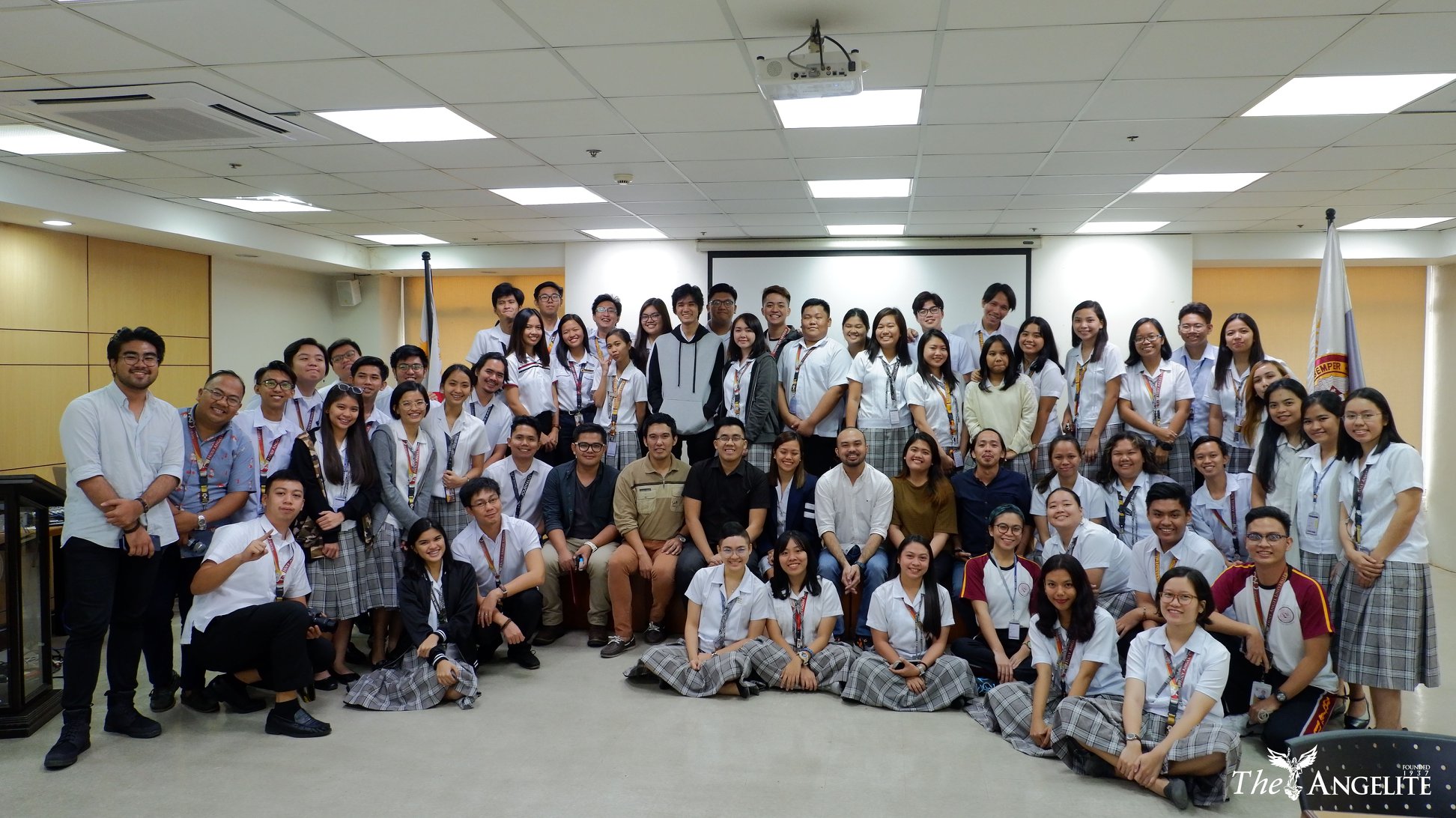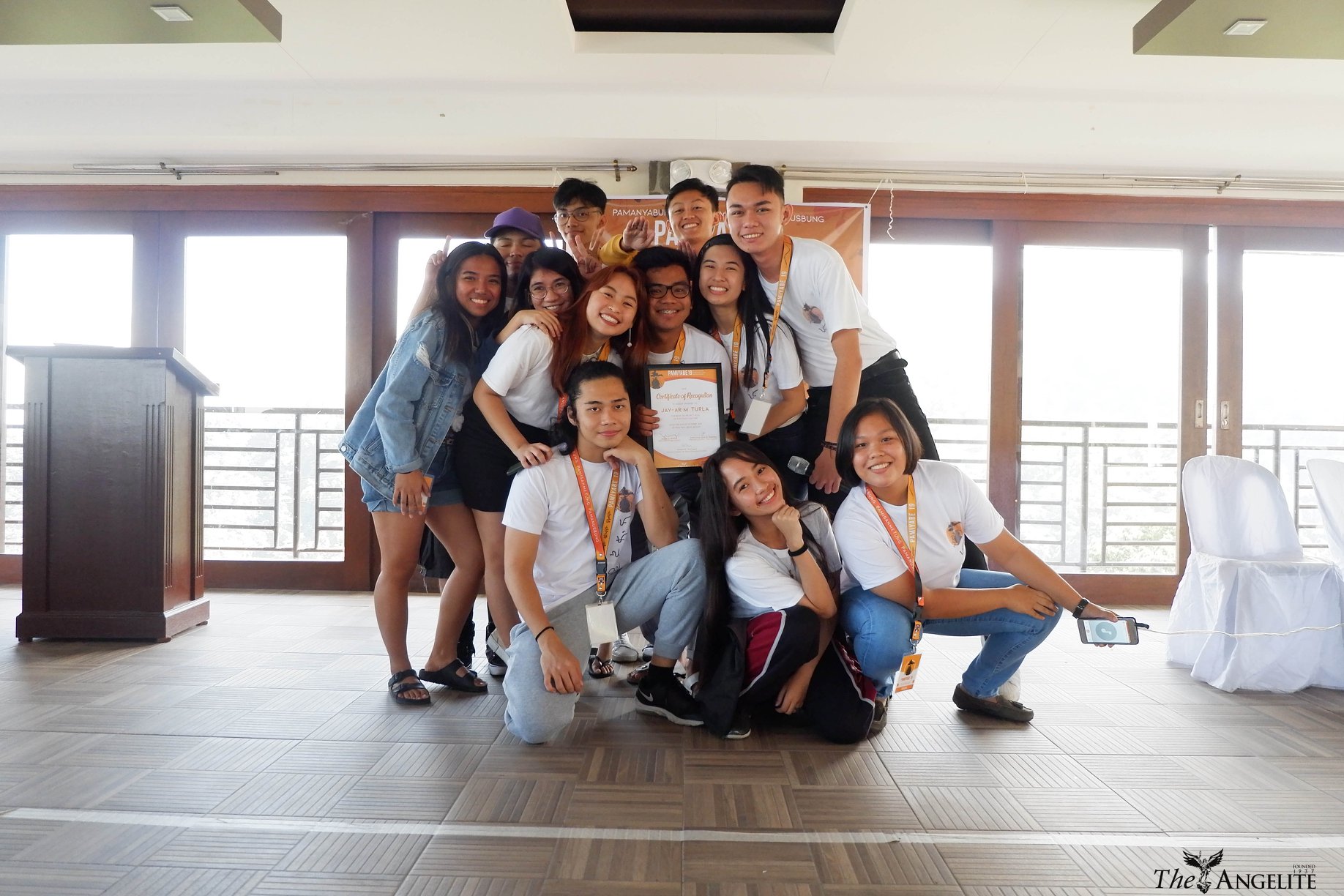The Angelite History
It started from 11 students
After the foundation of the then Holy Angel Academy in 1933, it took only three years before Holy Angel came up with its own school organ. In 1937, The Angelite was born which was pioneered by senior high school students of that year.
The idea in putting up a campus paper within the academy was conceptualized by Crisostomo Pamintuan which was inspired by the copy of the LaSallite (official paper of De La Salle-Taft) given by his close friend Javier Nepomuceno.

It started from 11 students
After the foundation of the then Holy Angel Academy in 1933, it took only three years before Holy Angel came up with its own school organ. In 1937, The Angelite was born which was pioneered by senior high school students of that year.
The idea in putting up a campus paper within the academy was conceptualized by Crisostomo Pamintuan which was inspired by the copy of the LaSallite (official paper of De La Salle-Taft) given by his close friend Javier Nepomuceno.
The birth of the publication was not easy, having only 11 students from the then graduating batch. Many questions, brainstorming and unending conversations on how to put up a school organ were raised. But, they never become hindrances to fulfill their mission.
The term “The Angelite” was derived from the LaSallite having the logo of an ‘Angel holding a Torch’ which was personally made by Jose de Guzman as the publication’s official nameplate.
As a start, The Angelite serves as a means “to encourage the students to participate in some school activities, and also a way of expressing their ideas and interest in the field of creative reporting and literary works.”
Being the class topnotch and the oldest brother of Crisostomo, Ignacio Pamintuan assumed the position of being the first Editor in Chief which was the idea of Ricardo V. Flores, the then school principal. Completing the editorial line-up, Josefina Malig attained the position of the first Treasurer (or what is now Managing editor) and Pedro Baula as the first Associate editor and Crisostomo holding the title as the founder The Angelite.
Thus, it is the start of the publication’s journey. The staff collected 60 centavos from the students so as to finance the printing expenses. There was a small Nepomuceno printing press at that time. Lay outing the paper was not that simple using the typesetting format or letter by letter. The publication releases a monthly issue containing 4 pages and a broadsheet type.
The Angelite remained in the hands of twenty-four high school generation from 1937 to 1961 with Paulo G. Malit as the last high school Editor in Chief. Then, in 1962 when the school was renamed Holy Angel College, the Angelite was finally handed to the college students. It was also the time within the brackets of 1962 and above when student activism is very common and many nationalists parties entered the school. The Angelite then is only group of friends who wanted to express their freedom and rights as a student. They release every month and remained independent without the supervision of the administration, and majority of the staffers are from the College of Liberal Arts.
The rise of Martial Law in 1972 was considered as the darkest downfall of the Angelite. All write-ups were burned and buried. It was during those times when all campus publication was suspended by the Marcos regime including The Angelite. As the journey continued in the early 70’s where the first quarter storm has been rampant in the university, we will find a vestige of the “Lost Voice” which we call The Angelite. The years 1972 to 1981 counter a riptide against the tiding the student governments as a result of the institution of Martial Law. Philippine education fell prey to the law of the voice of privilege that one echoed in students gradually languished in the light of military rule, hence, the repression of students’ rights. January of 1981, which marked the lifting of Martial Law, was a big break for the students. After a decade or so of the Angelite’s dissolution in the university, the newspaper fought for its rights and recognition along with the University Student Council. Under the initiative of the Kapit Bisig ng Mag-aaral (KBM) more and more concerned students joined the rally for the assertion of the students’ rights relative to student councils and publications.

The Angelite, which first appeared in newsletter form, was dependent, leverage on the USC both for funds and leverage. The newspaper was a striving occurrence which sought to be fully recognized, which tired to survive on financial instability, and which fought over circumscribed rights and had the following as its staff member: Gil Santos, Cynthia Magbag, Edgar Lopez, Edel Morales, Anette de Leon, Arlene Ma. Suarez. Later on, with the approval of its publication, the Angelite Staff was re-organized since most of the early staff members have already graduated. Planned by the USC Press Committee and under the editorship of Jose David Jr., the staff was composed of Edel Morales, Annette de Leon, Oman Surla, Nenita Sibug, Arnel Sugay, Carlos Ollado, Erica Suarez, Jonathan Baet, and Rey David, with Jose Dayrit as adviser.
The Angelite, which first appeared in newsletter form, was dependent, leverage on the USC both for funds and leverage. The newspaper was a striving occurrence which sought to be fully recognized, which tired to survive on financial instability, and which fought over circumscribed rights and had the following as its staff member: Gil Santos, Cynthia Magbag, Edgar Lopez, Edel Morales, Anette de Leon, Arlene Ma. Suarez. Later on, with the approval of its publication, the Angelite Staff was re-organized since most of the early staff members have already graduated. Planned by the USC Press Committee and under the editorship of Jose David Jr., the staff was composed of Edel Morales, Annette de Leon, Oman Surla, Nenita Sibug, Arnel Sugay, Carlos Ollado, Erica Suarez, Jonathan Baet, and Rey David, with Jose Dayrit as adviser.
Rules and regulations for the Angelite entrance examinations and the Constitutions and by-laws of the USC were drafted by the USC officers and then USC chairman Alex Caugiran, together with Jose David Jr. (these later appeared on the Angelite’s Vol. 35 special issue of July 1982). The Constitution “marked the completion of the most significant task of the incumbent officers”. The heightening crisis which cropped up and the havoc which spread in the campus urged the students to unite and layout such systematic structure of guidelines.
The voice of the students, which cried at its peak during the First Quarter Storm in the 70’s and continued in 1982, had to cease upon deemed futility. The administration which was resigned to student’s freedom of speech, press and assembly, refused to recognize the validity of MEC Order No. 62, series 1981 which “provide the essentials of students’ rights relative to their organization and publications on campus.” The Angelite having been able to collect for funds from only half the number of students had come short of funds. Thus, the staff decided to hold the publication time. From 1982 to 1983, the Angelite realized that she was meant to be an intermittent thing, appearing off and on in scholastic life. Every issue then was a struggle.
It has been almost three years since then, and the time came for the students, the potent force of the university did not hinder the coming back of The Angelite. The cry goes on, thundering and rending the air. The lost voice of students has finally returned. The militant struggles of the students paved the way for the come back of a long disputed issue of campus press freedom – The Angelite. After long and grueling dialogues, discussions, and not to mention boycotts, the Angelite has finally resurrected from the grave triumphantly and peacefully with more of anything the students can ask for. On November 29, 1985, The Angelite Editorial Examination which was given by the university student council, headed by Chairman Pedrito Pineda, was administrated by members of the faculty Cecile Yumul and Edna Santos both from the college of education. The test was given to determine who will qualify for the several positions in the school paper.
The results were announced by the USC on December 16, 1985, 15 examinees qualified with Mamerto Mercado, a B.S.M.I.E. student toping the said examination. At present, The Angelite initiates various projects such as Digmaang Rosas (formerly The Think!) the Angelite literary folio wherein a one time finalist in the 2001 Catholic Mass Media Award in Best Literary folio category and also in the concluded 6th Regional Press Conference in 2006. The annual release of the Balikat, official feature folio of The Angelite, the publication also holds different events that involve the students’ participation. In 2001 Pamiyabe the national creative writing fellowship of the Angelite was born. In 2006 the award giving body Gawad Digmaang Rosas paved its way to promote Kapampangan literature and to identify the best fictionist and poets around the university. And in 2007, The Angelite of the Year comes to light being the most prestigious award for the most outstanding Angelite, in line with celebration of the then Angelite at 70.
[Seventy-five] years ago, The Angelite was born. It has survived at least one decade of regime and is still now acclaimed as the region’s oldest existing campus publication. Through the years, the paper still serves as the concrete expression of the students’ artistic, creative, and progressive skills in writing. It serves as a necessary conduit among the academic community. And most important of all, it serves as the voice of the students, a catalyst for change, blurted out in pen.
Written and researched by:
Peter Jay B. Diaz
Sources:
The Angelite Volume 36 No. 1 February 1986
Angelite Restored and A story of the lost voice
The Angelite by Yen Gonora and Erica Suarez
Stories from Crisostomo Pamintuan dated December 7, 2008
